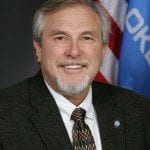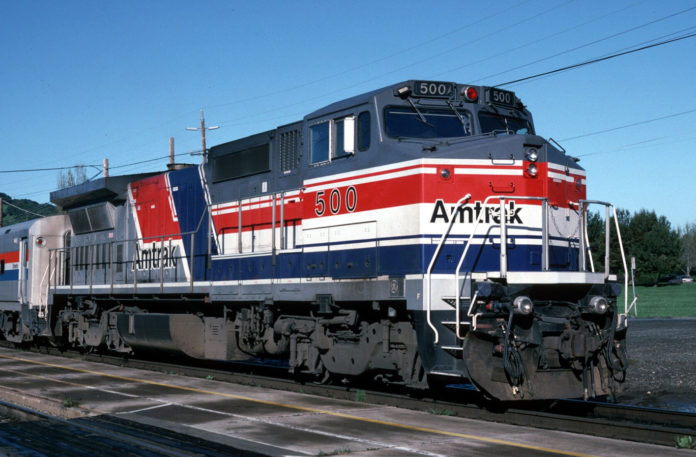BY DAVID PERRYMAN
 My first train ride was during the Vietnam War. It was a short ride from Sallisaw to Siloam Springs, AR. I remember that it was during the war because the train was also pulling a freight car transporting the body of an American soldier killed in southeast Asia.
My first train ride was during the Vietnam War. It was a short ride from Sallisaw to Siloam Springs, AR. I remember that it was during the war because the train was also pulling a freight car transporting the body of an American soldier killed in southeast Asia.
The train ride was really a kind of novelty trip. One of those “you better go now, because you won’t be able to for long.” Sure enough, a few months later, passenger service ended and only freight trains remained on the railroad tracks in Oklahoma.
Through the years, I have ridden several commuter rail, subways, elevated light rail and excursion trains, but no more in Oklahoma until the Heartland Flyer began running between Oklahoma City and Fort Worth.
There are a lot of reasons that passenger rail became a thing of the past in our state. Part of the reason was cheap 22-cent gas and cheap cars with no mandatory insurance requirements and the absolute convenience of not having to deal with anyone else’s schedule. We developed a mindset that makes us leave for trips or appointments at the absolute last minute to be able to get to a destination on time … or only a few minutes late.
As a result, we rank fourth in the nation in per capita gasoline consumption, driving an average of nearly 13,000 miles per year for every man, woman and child. Even with the fifth lowest fuel tax per gallon of gasoline, Oklahoma drivers annually send around $510 million to Washington.
Fortunately, we get back around $675 million per year in general highway funds. On average, that is about $1.31 in highway funds for every dollar that we pay in federal fuel taxes.
But the story does not end there. A fund that we come up short in is the mass transit fund, sometimes called the Surface Transportation Fund. Oklahoma is a donor state and actually subsidizes mass transit in places like New York, Chicago, Boston and Los Angeles.
Today, a lot has changed since passenger rail service ended. Gas is now 17 to 20 times more expensive often nearing $4 per gallon. Automobiles and auto maintenance and tires are no longer inexpensive and mandatory liability insurance stretches and tests the affordability of automobile ownership by many Oklahomans.
However, geographically, because of the distance that people must travel for work or doctors, they must have access to a vehicle. Most job applications ask about the availability of transportation. A mass transit rider’s mindset requires planning and forethought.
While a statewide passenger rail system would be the ultimate goal, a line connecting the Oklahoma City metro with the Tulsa metro and Lawton-Fort Sill would provide the backbone of a transit system through the state’s major centers of population. Ideally, such a rail line already exists. The Stillwater Central Railroad stretches, among other locations, from Tulsa through Oklahoma City, by Will Rogers International Airport and all the way to Lawton-Fort Sill and points west.
Two questions must be answered: is funding available to begin a passenger service and are Oklahomans ready to incorporate a mindset that deals requires them to incorporate transit schedules into the planning of their day?
If so, commuter costs would be decreased. Removing vehicles from the roads and highways would extend the life of roadways. Pollution would likely decrease and another possible benefit of mass transit would be a potential decrease in the number of uninsured vehicles on the road.
A part of the puzzle is the proverbial question of the chicken and the egg. Mass transit planners cannot expect full train cars as soon as the routes and schedules are planned. Rail schedules must be established in such a way as to entice ridership.
The future of passenger rail in Oklahoma, particularly along the I-44 corridor between Tulsa and Lawton, is an ideal subject for study. That is why I have requested an interim study on this subject so that the concept and the cost as well as the potential benefit may be studied this between now and the 2014 legislative session.
With a little foresight and proper planning, we may soon be hearing, “All aboard on the Thunder Express.”
– David Perryman, a Chickasha Democrat, represents District 56 in the Oklahoma House of Representatives








David Perryman’s record of thoughtful integrity and sterling service to Oklahomans is upheld once again in this piece. Thank you, honorable sir!
A railroad segment of which the Honorable State Representative speaks has been owned by the state and leased for operation by WATCO industries since 1998. The 97.5 miles between Oklahoma City and Sapulpa have been rehabilitated by a WATCO subsidiary, The Stillwater Central Railroad. The dilapidated 10-mph railroad, prone to derailments with a single online customer has been reborn as 25-mph railroad with additional upgrades in the queue. The Stillwater Central has also restored the customer base. The largest customer is a North Dakota oil shipper, delivering unit tank car trains of Bakken field crude to a transloading pipeline facility at Stroud.
Is it any wonder the BNSF Railway, a mega-railroad that allowed the route to sink into this dilapidated status prior to 1998 wants it back? Unfortunately, state transportation leaders seem ready to sell. With this sale Oklahoma will lose all control a proposed commuter rail route between Oklahoma City and Tulsa. These same transportation officials are making wild claims about the impracticality of the route for passenger rail service. These claims contradict what is already an obvious success in the Heartland Flyer. Go figure.
No, there are THREE questions that need to be asked. The first one takes absolute priority over the two Mr.Perryman has asked: Is the Oklahoma public willing to fight the Oklahoma Department of Transportation tooth and nail and prevail? If Oklahomans aren’t willing to engage the true enemy of passenger rail (and I mean score devastating hits on that unsinkable battleship known as ODOT) here in our state, then this whole issue of enhanced passenger train service is a lost cause. Really, how many folks in this state are willing to become like an army of David’s and go up against the modern-day Goliath known as ODOT and sling their stones — let alone draw out a sword and decapitate its head, hold it aloft and declare victory? Not many, obviously, considering that the HEARTLAND FLYER is still stuck at OKC 14 years later.
Mr. Perryman’s observations are enlightening. Now let’s see if he will gather some stones from the brook, look ODOT right in the eye, start slinging and fell the giant.
Elmer Burnside